Source: Violinist Nicole Cherry Honors Black Composers at River Oaks Chamber Orchestra Concert

ROCO Concertmaster Scott St. John and Dr. Nicole Cherry
The River Oaks Chamber Orchestra (ROCO) brings together musicians from all over the United States and Canada, working to ensure that classical music remains a living, breathing art form. Its Connections Series takes ROCO musicians to unique venues across the city. One of those venues was 5th Ward’s historic DeLUXE Theater, where violinist Dr. Nicole Cherry joined ROCO for a special concert on Jan. 25. The evening featured selections from Dr. Cherry’s project “ForgeWithGeorge,” inspired by the contributions of Afro-European violin virtuoso George Bridgetower.
George Augustus Bridgetower was a British musician of Polish and African descent. Born around 1778 in Poland, he showed musical talent at an early age. A child prodigy, he made his debut performance in Paris in 1789. He soon moved with his family to London, where the future King George VI took an interest in him and funded his musical education at the Royal Opera House and Royal Academy of Music. He went on to perform several concerts over the next decade. In 1803, he visited Vienna. There, he met and became friends with famed composer Ludwig van Beethoven, who dedicated a piece to him.
Like Bridgetower, Dr. Cherry is a talented Black violinist whose gift made room for her. After receiving her master’s degree in music from Juilliard, she went on to join the Marian Anderson String Quartet, which had previously won the International Cleveland Quartet Competition in 1991, becoming the first African American ensemble in history to win a classical music competition. Dr. Cherry joined in the early 2000s, and the quartet was Ensemble in Residence at Prairie View A&M University from 2001 to 2005.
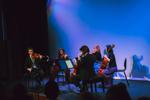
Cherry’s doctoral research at Texas Tech focused on Bridgetower and other Black musicians often omitted from history, inspiring her 2016 project “ForgeWithGeorge.” Now an assistant professor of violin at the University of Texas-San Antonio, Dr. Cherry aims to honor the legacies of little-known Black composers. In that vein, she collaborated with ROCO Concertmaster and Artistic Partner Scott St. John on this concert.
At a time when DEI is under attack, ROCO’s commitment to diverse voices is notable. A 2019 study by the Institute for Composer Diversity ranked ROCO the No. 1 ensemble for featuring works by women composers, as well as the No. 2 ensemble for composers of color. Thus, ROCO proved to be an ideal partner for the project. The location was intentional: “Performing in historic spaces like Houston’s DeLUXE Theater—the city’s first African American movie theater—carries a powerful resonance for me,” said Dr. Cherry. “It’s more than just a venue; it’s a testament to our history and resilience, and it deepens my commitment to honoring the past.”
Dr. Cherry reflected on the past in her onstage remarks. “It just gives me… goosebumps to think right here, right across the street, along the block: Cab Calloway. James Brown. Ray Charles. Martin Luther King, possibly—any number of people that could have strolled these streets and sent a message, served, or just been entertained, period,” she said. “I am very humbled by the opportunity to continue on that legacy, that platform that they set.”
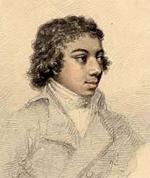
Notably, the concert was centered primarily on works by Black composers, starting with “Sonata for Two Violins” by Joseph Bologne, Chevalier de Saint-Georges. Born in the Caribbean in 1745 to a wealthy white plantation owner and an African slave mother, Bologne was taken to France when he was seven. He was enrolled in a private fencing academy there at 13. Bologne excelled as both a fencer, competing against the best swordsmen in Europe and becoming an officer in the court of King Louis XV, who made him a “chevalier,” (French for “knight”). But he also composed concertos, sonatas, and quartet pieces, becoming conductor of the Concert de Amateurs in 1773 and the Paris Opera in 1776. He became an all-too-rare sight in French society: a biracial free man of color.
His work “Sonata for Two Violins” was reimagined as a duet between Dr. Cherry and Mr. St. John. It provides a window into the musical environment of late-18th-century Paris but also showcases the skills of two talented players. “The interplay between the two violins reflects a delightful conversation,” the program notes enthuse, and indeed, the two violinists complement each other beautifully. Even in counterpoint, Dr. Cherry and St. John seemed to be in almost perfect sync.
The next two pieces were from the “ForgeWithGeorge” project. “I got stuck on George Bridgetower because of his fascinating life with the greatest of the great: Haydn, Beethoven in England and Vienna, as well as being patronized by King George IV,” Dr. Cherry said. “The next couple pieces are based on that idea: bringing to life the concepts and contributions of George Bridgetower. And these are two commissions that came out of my ‘ForgeWithGeorge’ project. I don’t want to talk too much about it. Because that’s the problem with getting a doctorate: you talk too much,” she said, to laughter. “However, I want to play for you two of those examples.”
The first, “Remembering 1619,” was composed in 2019 to mark the 400th anniversary of the first African slaves being brought to America. After meeting Harvard composition professor Dr. Yvette Janine Jackson, Cherry asked her to compose the work, which creates a connection between the Negro spiritual and 19th-century classical music. Specifically, the work connects the hymn “Go Down, Moses” with Niccolò Paganini’s “Moses Fantasia,” both of which examine the narrative of Moses parting the Red Sea.
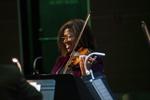
The beginning was unexpected: Cherry, in a high, clear, tremulous voice, sang the first few lines of “Go Down, Moses,” then began to play. “The violin’s voice becomes a storyteller,” the program notes say, and indeed Cherry gave the instrument its own dramatic voice: hair-raising high notes, dramatic pauses, even picking strings. But that voice was soon joined by another noise: was it thunder rolling? Steps creaking? Moving furniture? In fact, the electronic tape (courtesy of Dr. Jackson) is of a slave ship, demonstrating the looming horrors of slavery.
The mood lightened with the next composition, also commissioned by Dr. Cherry. She’d attended Juilliard with violinist and composer Dr. David Wallace, who wrote “If Only…a Fantasy on Rita Dove’s The Bridge Tower.” It’s based on part of “Sonata Mulattica,” a poetic novel by Rita Dove (the first Black person to serve as U.S. poet laureate) and dramatizes the relationship between Bridgetower and Beethoven.
As previously mentioned, Beethoven was so taken with Bridgetower’s talent that he dedicated a piece to him. Sonata Mulattica premiered in 1803, with Bridgetower practically sight-reading a piece he’d had no time to rehearse. He’d add brilliant, improvised flourishes to the work, thrilling Beethoven, who reportedly exclaimed: “Once more, my dear fellow!” But after the two fell out (over a girl), Beethoven instead devoted the piece to violinist Rudolph Kreutzer (who wouldn’t even play it). The piece dramatizes that fallout: “If only Ludwig had been better-looking,” it reads. “If he hadn’t drunk his wine from lead cups. If only he had found true love… They could’ve palled around some. Just a couple of wild and crazy guys strutting the town like rock stars.” Dr. Cherry moved deftly between different settings: from playing to singing, from sitting to standing.
The parodic, comedic piece came with a dramatic surprise when Cherry stopped in the middle of a passage. “I am so sorry. The violin has completely fallen.” Cold weather can damage string instruments, causing strings to break or go out of tune. Still, she soldiered through, gamely delivering these lines (half-sung, half-spoken, partly even rapped) in between passages of florid, flowing violin. Together, “Remembering 1619” and “If Only…” formed a piece of startling, dramatic performance art.
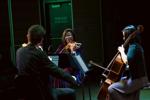
Next came the piece Beethoven had composed for Bridgetower. The Violin Sonata in A Major is better known as the Kreutzer Sonata (thanks to Beethoven). In 1832, a version written for string quintet was found. With Dr. Cherry and St. John on violin, Suzanne LeFevre (viola), Shino Hayashi & Philip Borter (both on cello), this lush, vivid piece was brought to life in a richly satisfying way.
The concert concluded with another unexpected choice: a trio version of jazz great Duke Ellington’s gospel-tinged “Come Sunday.” Written for his Black, Brown and Beige concert suite, the piece has become a jazz standard. But this string trio version gave it a distinct orchestral feel, placing one of jazz music’s greatest titans into a classical context—and achieving Dr. Cherry’s goal of honoring great Black composers.
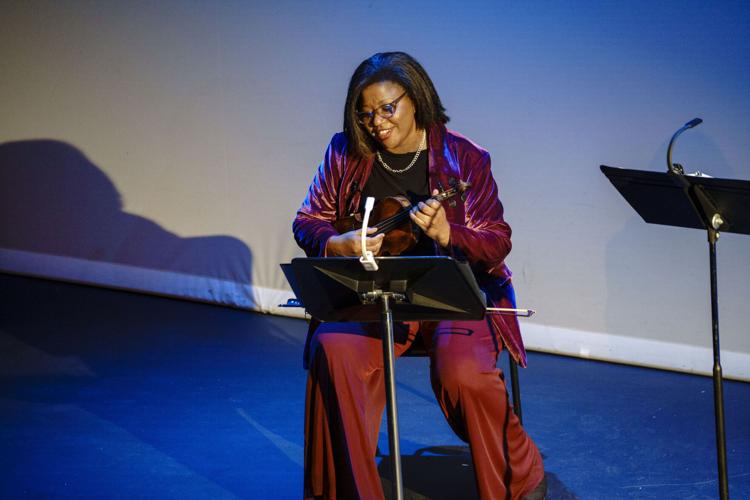

Leave A Reply